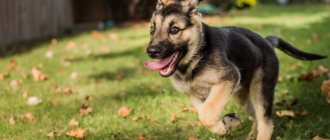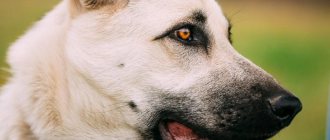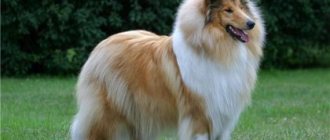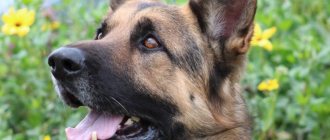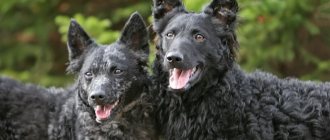One of the achievements of Soviet dog handlers is the East European Shepherd Dog. The breed, which was bred almost a century ago, has established itself as an excellent option for home protection.
These menacing-looking dogs are distinguished by their loyalty and friendliness towards their owners. Eastern Shepherds are unpretentious in their conditions of detention, but are selective in terms of their environment.
Expert opinion
Anna Abramenko
An avid dog lover. Experience in veterinary medicine since 2009.
Ask a Question
They do not require special care, are easy to train and are suitable for those who are looking for a worthy protector and friend in a pet.
Origin story
The East European Shepherd (VEO) is a breed whose history began in the 1930s on the territory of the Soviet Union. The breeders planned to create an improved modification of the German Shepherd, large in size and physical strength.
The difference in appearance is too pronounced, and therefore East European Shepherds were identified as a separate breed.
Dog handlers were faced with the task of creating strong and resilient service dogs, adapted to work in all weather conditions. Development began after the end of the First World War, but scientists achieved their greatest success after the Second World War.
Shepherd dogs of the fascist troops, remaining in Soviet shelters, became the ancestors of modern representatives of the Eastern European breed.
Choleric German and phlegmatic Russian
In character, NO is not much different from VEO. These are working breeds that are characterized by:
- equilibrium;
- obedience;
- high learning ability;
- lack of dominance towards a person;
- distrust of strangers;
- security and guard skills.
However, the NO was originally bred as a herding breed. Therefore, it is characterized by great mobility and liveliness.
Another difference between the East European Shepherd and the German is the type of temperament. BUT is choleric by nature, and VEO is half sanguine and phlegmatic. Easterners are more balanced, calm, and less active.
However, VEO has a more complex character. Her wariness towards strangers often develops into mistrust and open anger.
Description
The breeding of VEO was based on the selection of the largest German Shepherds. Later, dog handlers made attempts to instill in them the traits of huskies and Great Danes, which led to changes in the breed.
An example of such crossbreeding is the long-haired Oriental Shepherd. VEO is a large, tall dog with well-developed prominent muscles. The sexual type is clearly expressed - males are distinguished by their larger size and strong build.
One-year-old dogs look like adults, but shepherd dogs reach full maturity at 3 years.
Characteristics and standards
Visual characteristics of the breed according to the standard:
- height of males - 66-76 cm at the withers. The norm for bitches is 62-72 cm;
- body length is 10-15% longer than the first indicator;
- the head is proportional, length – 40% of the height at the withers, wide;
- the coat is hard, thick, straight;
- the color is zoned, black-backed, with a light background;
- the muzzle is wedge-shaped, with a developed lower jaw;
- nose large, black;
- ears are medium-sized, triangular, pointed, erect;
- neck with developed muscles, located at an angle of 45 degrees;
- the back is wide, strong;
- tucked belly.
Dog Character Traits:
- equilibrium;
- confident behavior;
- suspicious attitude towards strangers;
- activity;
- good defensive reaction;
- attentiveness;
- ability to learn.
This standard is approved by the Russian Cynological Federation (RKF). The document specifies the deviations allowed for the breed.
A separate section describes disqualifying defects - if a dog has them, then it does not meet the standard and cannot participate in competitions or be used for purebred breeding.
How to buy a purebred VEO puppy
In the 90s of the 20th century, they wanted to completely eliminate the “East European Shepherd” breed; therefore, acquiring a purebred “Eastern” is not entirely easy. At the age of two months, it is almost impossible to distinguish a young East European Shepherd from a German or a half-breed, so it is necessary to purchase a puppy from VEO kennels.
If you want to get a healthy and mentally balanced shepherd, you should only buy a Veo puppy from trusted breeders
Serious organizations involved in breeding East European Shepherds select sires, control all matings and register the resulting offspring. It is not always possible to purchase a puppy right away; in this case, it is possible to reserve a pet of the desired gender from selected manufacturers. A few months of waiting allows you to purchase a purebred “Eastern” with a good pedigree.
The cost of VEO puppies with documents from the Russian Canine Federation is on average 20,000 - 50,000 rubles, this is quite an adequate price for a purebred dog. If the proposed young East European Shepherd costs around 3,000 – 5,000 rubles, there is a high probability of purchasing a dog without a pedigree or a mixed breed.
Difference between German and East European Shepherd
VEO are recognized as a separate breed only in the CIS. The Fédération Cynologique Internationale defines them as a variety of the German dog.
However, Eastern Shepherds have many distinct individual traits:
- larger size and taller;
- smaller angle of inclination in the back;
- wider chest;
- predominantly light tone in color.
- VEO is more suitable for office tasks. "Germans" make good pets.
These breeds look similar, but are very different in character. “Germans” are more active and mobile. They are welcoming and friendly towards others. Eastern Shepherds are reserved and wary.
Working qualities
The differences between the German Shepherd and VEO are also evident in their work. BUT – plastic, suitable for any professional and sports discipline. Easterners are born watchmen and security guards, and they have difficulty mastering other skills.
The differences are visible when apprehending criminals. The Germans go into a frenzy, they try to catch up and capture the intruder at any cost, often they do not see or hear anything around. Easterners are always “in touch”, vigilant to little things. Therefore, they instantly switch to the owner, notice other intruders, and track the movements of arms and legs.
But with a long pursuit, the BUTs win. Shepherd dogs from Germany tirelessly follow the scent for 2-4 hours, and the domestic breed gets tired in less than an hour.
The Germans also beat the Easterners in sports disciplines. BUT they are light, agile, quickly master tricks and perform spectacularly. Against their background, East European Shepherds look like elephants in a china shop. Dogs are heavier, pass obstacles more slowly, and are not as enthusiastic.
The only thing in which VEOs are superior to BUTs is being guide dogs. Due to their emotionality and temper, Germans are not the best nannies.
Advantages and disadvantages
The Eastern Shepherd is an intelligent, loyal and calm dog. But keeping such a pet is not suitable for everyone.
The table shows the advantages and disadvantages of the breed:
| pros | Minuses |
| Acute vision and hearing | It is difficult to keep a dog in a small apartment; it needs prolonged physical activity |
| Endurance | |
| Devotion | |
| Learning ability |
Health
It is difficult to talk about the health status of this breed from a statistical perspective, because there are no serious studies.
But VEO received genes from several other breeds, and besides, it was bred for specific serious purposes.
Volvulus and dysplasia are the main problems that VEOs are susceptible to. The latter provokes pain and changes in the joints, but the former can lead to death.
The main cause of intestinal volvulus is physical exertion after a heavy meal. To prevent this problem from happening, you should give your dog food in small quantities and not engage in vigorous activity with it immediately after eating the food.
Colors
The East European Shepherd's coat should be well pigmented - this is a sign of the dog's health.
Zonar is characterized by a distribution of several shades: light at the root, brown and gray in the middle, and black at the tip. The coat looks pockmarked, with a grayish tint.
The breed is characterized by a saddleback color - a combination of a light tone and a black mask.
According to the standard, the following shades are acceptable:
- light gray;
- pale yellow;
- grey;
- zonal red color;
- black.
A dog's coat may have red or tan areas, but a solid color is not allowed by the standard.
Cost of dogs
Several factors influence the price of puppies:
- purebred;
- pedigree;
- health;
- compliance;
- availability of documents;
- image of the nursery.
The cost of dogs of both breeds is approximately the same: for pet-class puppies they ask for 15,000 rubles, breed-class will cost the buyer 20,000-30,000 rubles, show class costs 30,000-40,000 rubles.
Character and appearance
Shepherd dogs of Eastern European origin have the following characteristics:
- curiosity;
- developed intelligence;
- friendliness to children and animals;
- restraint;
- courage;
- devotion.
This breed is ideal for guarding a home or territory and will not cause inconvenience to family members.
These dogs are quite large and proportionally built. Despite their advantage in strength, they do not offend the weak: children, animals. Shepherd dogs are active, hardy, curious and take part in family leisure time.
Maintenance and care
You can keep VEO both in a private house and in an apartment. Since they are large and active, the first option is preferable. Before a dog comes into the family, you need to decide where it will live: inside or outside the house.
A pet that has lived in a kennel can cause damage to furniture and repairs. And a shepherd who is accustomed to comfortable home conditions will be very worried.
Expert opinion
Anna Abramenko
An avid dog lover. Experience in veterinary medicine since 2009.
Ask a Question
Inside the home, the dog should have its own place - secluded and moderately warm. Bedding should be placed there and access to water should be provided.
A shepherd dog living in an apartment should be walked at least twice a day.
Caring for VEO is extremely simple. She needs basic hygiene, exercise and good food. You need to bathe your dog twice a year. The rest of the time, brushing is sufficient.
You need to inspect your pet's ears and clean them of dirt. If necessary, you can brush your teeth to remove plaque. At the end of spring and beginning of autumn, a flea treatment is carried out.
Vaccination of puppies and adult dogs VEO
If VEO puppies are born from vaccinated mothers and fed with breast milk, the first vaccination against infectious diseases should be given to young pets at the age of 2 months. For vaccination, immunobiological preparations Nobivac, Eurican, Vanguard, Canigen, Duramune, Hexadog, Dipentavac, Hexakanivac are used for vaccination. Up to 12 months, young animals are vaccinated 3 times:
- at 2 months – first vaccination;
- at 3 months – revaccination;
- at 6-7 months – third vaccination.
At 15-18 months the fourth vaccination is carried out, the next vaccinations are given annually once a year. It is advisable to vaccinate young and adult animals in a specialized clinic, where a mark is placed in the veterinary passport on the date, dosage and name of the drug.
It is important to remember that before the first vaccination the puppy is vulnerable to infections.
The conditions for vaccination are:
- deworming 10-14 days before vaccination with antiparasitic drugs;
- absolute health – the dog three days before and on the day of vaccination should have a clean nose and eyes, good appetite and activity, normal body temperature;
- quarantine - until it reaches 2 months, it is forbidden to walk with an unvaccinated puppy. 3 days before and 10 days after vaccination, animals of any age should not change their diet, use increased physical activity, or bathe in the bathtub or open water.
Lactating, estrus and pregnant bitches, sick animals and puppies during their teeth change are not allowed to be vaccinated.
Education and training
This breed of service dog is highly trainable.
VEO representatives are obedient, treat family members with respect and do not try to dominate. Raising a dog must begin from the very first months of its life.
The puppy understands the owner almost immediately. Educational sessions should last a total of 10-15 minutes a day. At an early age, dogs do not tolerate prolonged training and cannot maintain concentration for long.
At 1.5 months, the puppy is already able to learn easy actions. But it is advisable to adhere to these rules:
- do not allow your pet to get tired;
- practice commands from simple to complex;
- do not use physical force;
- The combination of a voice command and a gesture is most effectively learned.
The first thing a puppy is taught is: a name, a collar and leash, and the command “sit” and “lie down.” After six months, the puppy masters “stand”, “fu”, “give”. Next, the dog is taught more complex skills.
Key points in training
Considering that the East European Shepherd belongs to the class of service breeds, the loads should be of high intensity, this is especially important for dogs that are kept in an apartment.
Dogs work very well in pairs, but you need to keep in mind that mature males at the age of 3-4 years can be aggressive towards their relatives.
They respond well to training and show good results. They are very attentive to their owner, which is why they remember commands quickly and assimilate them well.
Physical violence is not applicable. You can achieve the opposite effect.
The minimum that these dogs need is a general training course (GTC), which is best taken in a specialized club. However, given the common problems with the development of the muscles of the hind legs, it is recommended to use special exercises of low intensity, but long in time.
The training regimen should be as follows:
- For the first 2 months , the dog must be exercised with long walks.
- After this period, you can include more intense activities: running, swimming. A sudden increase in load is not recommended.
- Strength training is carried out 3-4 times a week, while the “mental” state of the dog is carefully monitored. It is best to choose an individual plan according to which your pet will be trained.
- Read about how to properly train a dog in the article: “Training a puppy: effective methods from dog handlers, learning commands at home.”
The attitude of a shepherd dog to a person
European Oriental Shepherds recognize the master not as the one who feeds, but as the one who teaches. All family members can take part in the training process - the dog will treat them more respectfully.
These animals are well aware of the status of each person entering the house. Well-mannered shepherd dogs do not attack family members. Guests are treated with caution and their behavior is carefully studied.
If the person has not gained trust, the dog may react aggressively. In case of open expression of hostility towards the owners, she attacks.
VEOs get along well with children and are patient when dealing with them. Some shepherd dogs are happy to join in games, and during a walk they act as a guard.
Learning ability
It is impossible to say for sure who is easier to train - VEO or NO. Both breeds are well trained, obedient, and intelligent.
But there are still differences. They come from the character of the dogs. Easterners are sensible and treat their studies as if they were work. And the Germans are gambling. For them, practicing commands is a game, a competition. BUT they like to set a record in one training session and break it in the next.
The difference between the German Shepherd and the Eastern European is also manifested in the psychotype. BUT matures faster, and VEO remains a puppy until 2-3 years old.
In the initial stages of training, the German Shepherd will amaze you. She tirelessly masters one command after another, learns complex elements, and obeys unquestioningly. In contrast, the Easterner works more slowly, is sometimes stubborn, and needs more time to understand orders.
But with long training, VEO will win. BUT – choleric, prone to hysteria when overworked. And the Oriental Shepherd works tirelessly, she understands that work is more important than her feelings and desires.
Nutrition
The East European Shepherd is unpretentious in terms of food. These dogs can maintain stamina even with poor nutrition, but it must be complete to maintain important functions.
Most of the foods allowed for feeding are present in the standard human diet.
Sources of carbohydrates for dogs:
- cereals (buckwheat, pearl barley, oatmeal, rice);
- sugar-free bakery products;
- vegetables;
- fruits.
To maintain physical fitness, shepherd dogs require protein:
- meat;
- offal (lungs, kidneys, liver, hearts);
- fish;
- cottage cheese;
- kefir;
- yogurt.
To avoid intestinal volvulus, you should feed the Oriental Shepherd Dog in small portions, but more often.
At 1 month, the puppy should eat 4-5 times a day. Feeding frequency: every 4 hours. Portion weight – 200 g. Products include beef, cottage cheese, milk, kefir, chicken eggs, buckwheat. It is acceptable to give an omelet.
By three months, increase the portion to 300 g. Half of the diet should be dairy products, a quarter should be meat, the rest should be vegetables, cereals, and soups.
At 4 months, the number of feedings is reduced to three per day. The weight of each serving is 300 g. The ratio of products is the same. At 5-6 months, 400-500 g of food are consumed per meal. By the year the serving size doubles.
Diseases and life expectancy
Eastern Shepherds have a strong immune system, but can become infected. Adult healthy dogs cope with them quickly. This breed is strong and hardy, but has a tendency to joint diseases: arthritis, rickets, dysplasia.
The average life expectancy of VEO is from 9 to 12 years. In the process of selection of this breed, it was possible to avoid a number of ailments characteristic of “Germans”. For example, ear diseases.
Some shepherds are prone to gastric volvulus. In this case, it is important to monitor the dog’s nutrition and activity after feeding.
Many diseases are inherited. The breeder can hide their presence from the puppy's parents. If possible, it is advisable to request information about the health status of your ancestors.
Height and weight of an East European Shepherd puppy by month
A VEO puppy reaches the size and weight of an adult animal at 8-9 months, but muscle formation and an increase in the amount of subcutaneous fat continue up to a year. The build of a dog depends on heredity and the quality of feeding and maintenance of growing young animals.
Table of height and weight of the VEO puppy by month
| Age (in months) | Height at the withers of a male dog (cm) | Height at the withers of the bitch (cm) | Weight (kg) |
| 1 | 23-27 | 23-25 | 3-5 |
| 2 | 35-38 | 33-36 | 8-10 |
| 3 | 43-47 | 41-46 | 12-15 |
| 4 | 50-55 | 48-53 | 15-20 |
| 5 | 55-60 | 55-57 | 20-25 |
| 6 | 60-65 | 57-65 | 25-30 |
| 7 | 65-68 | 65-66 | 30-35 |
| 8 | 68-70 | 66-67 | 35-40 |
| 9 | 68-73 | 66-68 | 35-40 |
| 10 | 68-75 | 66-69 | 35-40 |
| 11 | 68-75 | 66-69 | 35-40 |
| 12 | 68-75 | 66-69 | 35-40 |
Changes also occur in other parameters of the shepherd dog.
Choosing a puppy
Shepherds are common pets, so you can often find various crossbreeds that visually resemble them. A non-purebred dog may lack the qualities characteristic of the breed, be in poor health, or be unable to be trained.
Most often, market traders deceive buyers by offering to buy a shepherd dog cheaply without documents. It is also risky to pick up a puppy from your hands. Conscientious breeders breed only purebred shepherds and can provide a pedigree.
It is better to purchase a dog from a kennel that has a registration certificate. This is a guarantee that you are buying a real VEO without congenital mental or health defects.
At a young age, only a few characteristics of a dog can be assessed: its reaction to sharp sounds and to strangers. In this case, you can only rely on the behavior of the parents. Older puppies may have certificates of completion of a training or protection course.
Expert opinion
Anna Abramenko
An avid dog lover. Experience in veterinary medicine since 2009.
Ask a Question
At the age of 1 to 2 months, the dog will most comfortably endure being separated from its mother and moving to a new home. At this time, certification takes place - diagnosis of disqualifying defects. Then the puppies are given nicknames and documents are filed.
Mature individuals at the age of 4-5 months adapt normally to a new family, they have received vaccinations and skills. But they also already have habits that may not correspond to the idea of dog behavior.
Expert opinion
Anna Abramenko
An avid dog lover. Experience in veterinary medicine since 2009.
Ask a Question
After moving to a new home, the puppy should eat according to the breeder's recommendations. If the diet of a small shepherd changes too dramatically, consequences such as an upset stomach or refusal to feed may occur.
Interesting Facts
Dogs were faithful comrades of Soviet soldiers. Many of them had a difficult fate - they heroically served for the good of their homeland.
During the Great Patriotic War, shepherd dogs helped sappers, pulled the wounded out of the battlefield, and delivered ammunition and notes. In memory of these exploits, a monument was erected in Moscow called “Monument to the Front-line Dog,” the sketch for which was modeled from a shepherd dog.
The dog Dzulbars, who played in the 1940 film “White Fang,” especially stood out. This shepherd has found mines on the streets, in historical buildings, hospitals in Russia, Ukraine and eastern Europe.
The dog was awarded the medal “For Military Merit” and participated in the Victory Parade. His limbs were broken, and he could not move independently around Red Square. Having learned about the situation, Joseph Stalin ordered the hero to be carried in his arms and personally provided his overcoat for this.
Reviews
Elena Krasina: Many people are surprised how such a serious dog gets along in a house with children. In fact, our Baikal is a calm, intelligent and good-natured dog. He understands perfectly who his family is and who needs to be protected. We always feel safe because we have invested time and effort into raising him.
Oleg Ryabin: I have been the owner of a shepherd dog for several years, and I can’t imagine another breed nearby. I have known the breed since my service days. Loyal and obedient dogs, and most importantly, excellent helpers.
Evgenia Zotova: My relatives kept Oriental Shepherds all their lives, and each one was like a family member to us. I can't imagine a more loyal dog. For me, shepherd dogs will always be the smartest and most beautiful breed.
The Eastern Shepherd is suitable for any owner, be it a housewife with many children or a single traveler. This breed is for those who are looking for smart and loyal pets, but do not want to deal with the disadvantages of exotic dogs.
